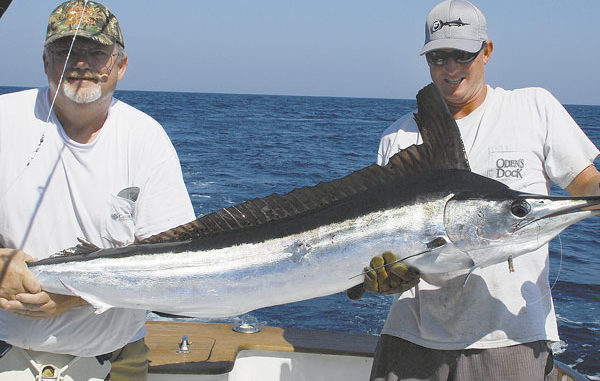
Marlin are an oft-ignored species out of Oregon Inlet, but they’re more than a match for many fishermen.
Maybe it’s the result of tight federal catch limits, the change-over to circle hooks or the catch-and-release of almost everything, but the past few years have produced square miles of striped bass to the 60-pound class, thousands of 300-pound bluefin tuna, a historic sailfish summer, and as many white marlin as any other season.
Be at the right place at the right time, and you’ll bump into them all. As far as place, nowhere beats the Outer Banks. As far as time, look for bluefin tuna in late winter and early spring, stripers in the winter and sailfish in August. Look for white marlin from mid-August to late September. That’s all you need to know.
That’s all we knew when we met Jeff Ross, captain of the Obsession, on the dock at the Pirates Cove Fishing Center at 4 o’clock one morning last August. Our plan was to catch the peak of the white marlin run; we were about a week early but still hooked eight billfish.
Skippers who operate out of the three main marinas that send boats to the ocean through Oregon Inlet all know the ocean floor, including the mountains and canyons where the currents merge and the fish aggregate. They rig meat baits, run slowly, and catch more tuna and billfish than boats elsewhere.
“It’s early in the run,” Ross said. “Yesterday they were in the mixed water on this side of the Gulf Stream right below the Virginia line, but the Stream is so far east, it will be a right long ride,” Ross said.
It took three hours of running, but you go where the fish are, as Willie Sutton might have said.
Many Oregon Inlet skippers have been fishing Mexico during the winter, when the sailfish are thick and so close to the beach that a half-day charter can be enough. Sailfish are great light-tackle fish, and the practice of stand-up fishing for them has migrated northward from Mexico and is now standard-operating-procedure during the sailfish and white marlin runs along the Outer Banks in late summer and early fall.
Ross uses Shimano TLD 20-pound class lever-drag reels loaded with 30-pound line — about 1,000 feet of braid topping regular monofilament — on matching rods so light and easy on the arms you can fish them all day. The mates set out six stand-up outfits baited with a small, well-salted ballyhoo without any skirt, with their jaws wired shut, weighted with a barrel swivel and trailing a 7/0 Lazer Sharp or Eagle Claw circle hook. The hook is too large and awkward to run through the bait, but dangling works just fine.
In case a blue marlin might appear, the mate set out an 80-pound class sit-down outfit with 100-pound line, rigged with a big squid sewn over a J-hook. You can’t run a big bait with a circle hook because the shank is too short and there’s a lot of drag; they don’t run in a life-like manner. Spanish mackerel or mullet are equally good baits, but fresh is what matters the most.
An additional 80-pound outfit rested in a rod-holder in case a blue popped its head up and we had a live dolphin or small tuna vibrating in the box. To a blue, that’s a jelly bean.
Ross said we would head for the 50-, 80- or 100-fathom curves, some 30 to 100 miles off the beach off the Virginia-North Carolina
state line.
“We’ve been finding them at the 100-fathom curve in beautiful clear, warm, 76- to 78-degree water, 95 miles from Oregon Inlet,” said Ross, who sometimes finds them ganged up in August, sometimes September.
“But it’s always between August first and October first,” he said. “White marlin and sailfish follow food, and whatever they are eating is now this side of the Gulf Stream, not in it. Could be sardines, herring, mackerel, or anchovies.”
The handful of boats on the horizon were spread out and searching for fish. We didn’t hear any radio chatter for about an hour, and then every boat had fish on. Ross got that pained and strained look on his face that said we were in a competition, he was the coach, and we’d better produce. Nobody wanted to walk home.
Dolphin hit first, and we switched to lighter spinning and baitcasting outfits, packing lots of meat for the ice box, moving over and under each other to avoid crossed lines. This late in the season, they were all small, chicken dolphin, but we boated around 50. When the first billfish showed up, the kid stuff ended and we went back to work with the regular stand-up tackle.
If the action wasn’t non-stop, it was close enough. We hooked eight billfish, releasing three white marlin and a sailfish; the other fish released themselves.
Losing half the hookups was a bad score; you need to know what you’ve got to do before you’ve got to do it. The moving boat hooks the fish, any additional jerk will rip the hook away, so hold the rod tip high to keep on pressure. When the line goes slack, you take it up fast; slack can mean the fish is running toward the boat.
The Shimanos were set to way-back to strike, three to four pounds of drag pressure. Pushing the lever slightly forward increases the drag, but it’s more important is to crank continuously to wear the fish down. Leaning into a stern corner or back against a chair works briefly, but a guy needs to get to the other side of the boat fast if the fish switches directions.
When a fish runs under the boat, Ross will tap the throttle to speed up so the line doesn’t wrap around the prop. Stand-up means fighting for your balance as well as your fish, and it’s a busy job with no time-outs. Most battles with a white marlin last five to 15 minutes but seem longer.
We also hooked four yellowfin tuna at once, boating two. Those battles were definitely longer; we didn’t throw the tuna back.
Billfish are universally released, except for huge blues in tournaments. Mates usually unhook them in the water at the side of the boat. Photos of fishermen holding up a 35-pound sailfish or 60-pound white marlinare popular, but a mate will lift a white marlin up only if specifically asked and if it’s not risky.
Fishermen who want mounts of their billfish cam get fiberglass models that roughly resemble them in size and shape, but they’re still stand-ins. Cameras will provide the best evidence of a billfish landing. Many boats now have topside video cameras to record the battle, and you can photograph the mate holding your fish or the mate can photograph you.
You’ll see its eyes moving back, down and around trying to figure out what’s happening. You’ll see flashing neon-blue iridescence as the fish takes it in. You’ll realize this fish is smarter than your dog and possibly your best friend. When you throw it back and it rockets off, that’s as big a kick as when it jumped clear of the water or you brought it to the boat. You’ll get a release citation from the N.C. Division of Marine Fisheries.
On the way back to port, the mate will clamp scorecard pennants to the outrigger lines, a white silhouette on a blue background signifying a white marlin, a blue silhouette on a white flag for a blue marlin, and a sailfish silhouette for a sailfish. A flag flying upside-down signifies a release. Some days during the peak of the run, boats might fly as 20 flags upside down. A single blue marlin flag is a big deal.
The marinas at Pirates Cove in Manteo, Broad Creek in Wanchese and Oregon Inlet on the southern tip of Bodie Island, all have top-notch skippers, and you can’t make a bad choice. The cost of a full-day charter to the Gulf Stream is $1,500 to $2,000 depending on the marina, the speed, age, size, and equipment on the boat, the skipper’s reputation and most importantly, the current price of fuel. Figure another 15- to 20-percent tip for the mate. Charters are limited to six fishermen.
If the whites move south — it depends on where the bait moves — you might have a shorter run out of Hatteras Inlet. Check newspaper or magazine fishing reports and marina and tackle-shop websites. It’s easier to get a boat on a weekday, and reservations on a top boat often require reservations months in advance.
Spearfish?
Spearfish are small marlin with a long, low dorsal fin from the nape nearly to the tail.
Most skippers recognize them by neon flashing while in the water, but not all spearfish show it, so we may have more than one kind.
Dennis Endee of Wanchese, skipper of A-Salt Weapon, has great spearfish photos on his web site, A-SaltWeapon.com. Ross said he saw spearfish mostly in April and May, and mostly in deeper water.

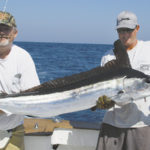
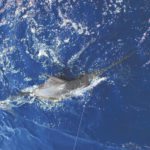
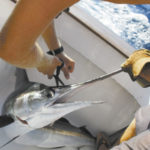
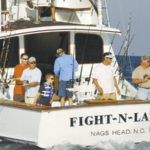


Be the first to comment